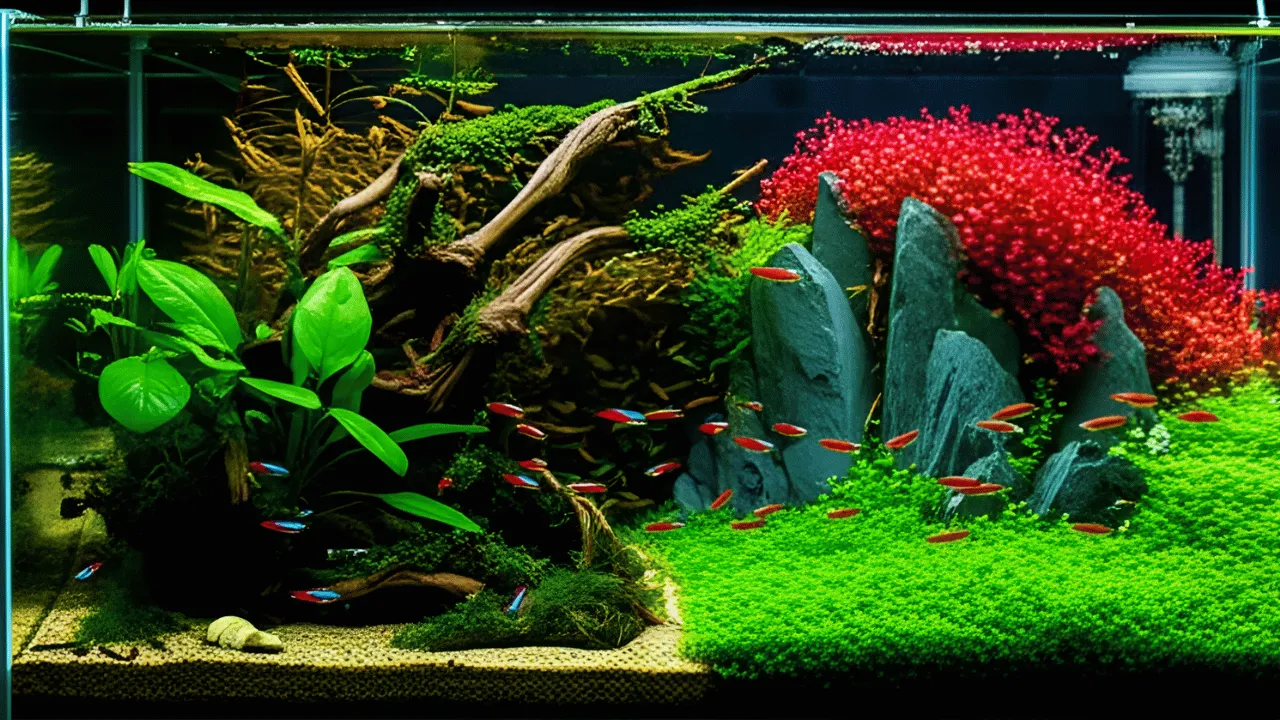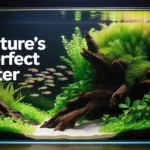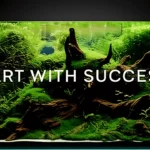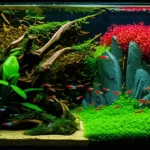Hey there, fellow fish keeper. Let’s have a real chat.
If you’re anything like I was when I first started, you’ve probably spent hours scrolling through social media, mesmerized by those incredible underwater jungles. You see these aquascapes bursting with vibrant green carpets, deep red stems, and crystal-clear water, and you think to yourself, “I have to have one of those.”
But then the research begins, and your excitement quickly turns to confusion. You’re bombarded with a whole new language: CO2 injection, PAR values, dry ferts, Estimative Index, aquasoil… It’s overwhelming. It’s enough to make you feel like you need a degree in chemistry just to keep a few plants alive.
I’m here to tell you to take a deep breath. It doesn’t have to be that complicated.
After years of building, flooding, battling algae, and eventually creating aquariums I’m truly proud of, I’ve learned that all that complex jargon really boils down to two distinct paths: the low-tech way and the high-tech way.
Today, we’re going to break down exactly what separates these two methods. We’ll ditch the confusing technical talk and focus on what this stuff actually means for you, your wallet, and your free time. By the time we’re done here, you’ll have a rock-solid idea of which path is the right one for you to start your own underwater garden.
Also Read: The Ultimate Beginner’s Guide to Low-Tech Aquascaping (No CO2, No Stress!)
The Low-Tech Approach: The “Chill” Method
Let’s start with my personal favorite for anyone entering the hobby: the low-tech planted tank. I like to call this the “chill method.” Think of a slice of a natural pond or a slow-moving stream. Everything is in balance, things grow at a relaxed pace, and it doesn’t demand your constant attention. It’s about creating a tiny, stable ecosystem that largely runs itself.
This approach, often inspired by Diana Walstad’s famous “Walstad Method,” is built on the idea of simplicity and natural balance. It’s forgiving, it’s beautiful in its own right, and honestly, it’s the best way to learn the fundamentals of aquatic plants without pulling your hair out.
So, what does a low-tech setup actually involve?
1. Lighting: Keep it Simple
In a low-tech tank, you’re intentionally using lower-powered lighting. We’re not trying to replicate the surface of the sun here. A simple, budget-friendly LED light that comes with a standard aquarium kit is often more than enough. You’ll typically run these lights for a shorter period, say 6 to 8 hours a day.
The reason for this is simple: light is the gas pedal for plant growth. The more light you provide, the faster the plants want to grow, and the more fuel (in the form of CO2 and nutrients) they demand. By keeping the light low and gentle, we keep the plants’ demands low. This single choice is the key to why the rest of the low-tech system works so well and avoids the dreaded algae outbreaks that plague so many beginners.
2. Carbon Dioxide (CO2): Just Breathe
This is the single biggest difference and the main reason the low-tech path is so much more approachable. There is no injected CO2. You don’t need to buy expensive pressurized canisters, regulators, timers, or diffusers.
So where do the plants get their carbon? From the natural processes already happening in your tank. The fish release CO2 when they breathe. The natural breakdown of fish waste and uneaten food releases a small amount. It’s not a lot, but combined with the low-light approach, it’s just enough for a whole category of beautiful, hardy plants to thrive.
3. The Substrate: A Hidden Powerhouse
This is the secret weapon of a great low-tech tank. Instead of using plain, inert gravel or sand, many low-tech tanks use a layer of organic potting soil or a specialized dirt-like substrate, which is then capped with a layer of sand or fine gravel to keep it from clouding the water.
Think of this soil layer as a nutrient-packed battery for your plants. It slowly leaches essential food directly to the plant roots over a very long time—often for years. This means you don’t have to worry nearly as much about adding liquid fertilizers to the water, because your plants are getting a steady meal right from the source. It’s a wonderfully effective and natural system.
4. Plants & Maintenance: Easy Does It
The plant selection for low-tech tanks consists of the tried-and-true workhorses of the hobby. We’re talking about beautiful and nearly indestructible plants like Anubias, Java Fern, Cryptocorynes (or “Crypts”), Amazon Swords, and various mosses. These are the easiest plants for a low-tech aquarium because they are adapted to lower light levels and don’t need extra CO2 to look great.
Maintenance is a dream. Because growth is slow and steady, you’ll only need to trim your plants every few weeks, or even months. Water changes are often smaller and less frequent. It’s a setup that respects your time and allows you to simply sit back and enjoy the view.

The High-Tech Approach: The Aquascaper’s Dream
Now, let’s step into the fast lane. The high-tech planted tank is the opposite of chill. It’s a system built for one purpose: maximum control for maximum growth. This is how aquascapers create those competition-level tanks with lush, perfectly manicured carpets and stems of fiery red plants.
If the low-tech tank is a self-sustaining nature trail, the high-tech tank is a hydroponic laboratory. You are manually providing every single element a plant could ever want, in precisely controlled amounts, to achieve explosive growth. It’s an incredibly rewarding challenge, but it demands knowledge, investment, and your constant attention.
Here’s what powers this high-performance machine:
1. Lighting: Bring on the Sun!
High-tech tanks use powerful, high-intensity lighting systems. These are advanced LED fixtures that are designed to blast the plants with energy, driving photosynthesis into overdrive. This intense light is what unlocks the vibrant colors and dense growth you see in showcase tanks. But remember our gas pedal analogy? This is flooring it, which means you absolutely must provide the fuel to match.
2. CO2 Injection: The Non-Negotiable Engine
This is the heart of any true high-tech system. A pressurized CO2 system is essential. It constantly injects a controlled stream of carbon dioxide into the water, providing plants with an endless supply of their most critical building block.
Mastering CO2 injection—finding that perfect balance where plants are thriving but fish are still safe—is the biggest learning curve for any budding aquascaper. It’s the one element that, if gotten wrong, can cause the most problems, from massive algae blooms to harming your livestock.
3. Fertilizers: The Daily Feast
With plants growing so fast, they are incredibly hungry. The nutrients from fish waste alone aren’t nearly enough. High-tech hobbyists use a method called “dosing,” where they add a comprehensive suite of liquid fertilizers directly to the water on a strict schedule, often daily. They add everything: Macronutrients (Nitrogen, Phosphorus, Potassium) and Micronutrients (Iron, Manganese, etc.). This ensures the plants never run out of food for a single moment, allowing them to take full advantage of the high light and CO2.
4. Substrate & Plants: The Artistic Palette
The substrate is often a specialized commercial product called “aquasoil,” which helps buffer the water chemistry to be more favorable for plants. With this level of control, your plant choice becomes virtually limitless. Want a perfect green carpet of Monte Carlo? Want stems of brilliant red Rotala? Want to try that rare, demanding plant you saw online? A high-tech tank is where you can make it happen.
5. The Catch: Cost and Constant Care
This level of control comes at a price. The cost of a high-tech vs low-tech planted tank is night and day. A quality lighting and CO2 system can easily set you back several hundred dollars. The ongoing cost of fertilizers and CO2 refills adds up.
Furthermore, it demands your time. You’re committed to a weekly routine of large 50% water changes, aggressive plant trimming, and dialing in your equipment. Because the system is running so fast, any small imbalance can lead to algae problems in a high-tech planted tank almost overnight. It’s a thrilling but demanding system.
The Final Verdict: Which Path Is Right for You?
Okay, we’ve laid it all out. The calm, self-sustaining world of low-tech, and the vibrant, fast-paced world of high-tech. Now for the most important question: which one should you choose?
After all my years in the hobby, and after helping countless people start their own tanks, my advice is this:
If you are a beginner, if you are on a budget, or if you have a busy life, please start with a low-tech planted tank.
I cannot stress this enough. The number one reason people leave this hobby is frustration. A high-tech tank, while beautiful, presents so many opportunities for frustration when you’re just learning. You’ll be fighting algae, worrying about your CO2 levels, and stressing over fertilizer chemistry.
A low-tech tank allows you to learn the fundamentals in a forgiving environment. You will learn how to grow plants successfully. You will build confidence. You will create a beautiful, living piece of nature in your home with a fraction of the stress and cost. And the success you have there will fuel your passion for years to come. You can always upgrade to a high-tech system later once you’ve mastered the basics.
The high-tech path is for the established hobbyist who is looking for a new mountain to climb. It’s for the aquascaper with a clear artistic vision. It’s for the person who loves tinkering with gadgets and finds joy in the daily process of fine-tuning a complex system.
Ultimately, there is no “better” choice, only the choice that’s better for you. Whether you opt for the quiet beauty of a low-tech setup or the dazzling performance of a high-tech one, you’re embarking on one of the most rewarding journeys there is. You’re not just keeping fish; you’re building a world.






